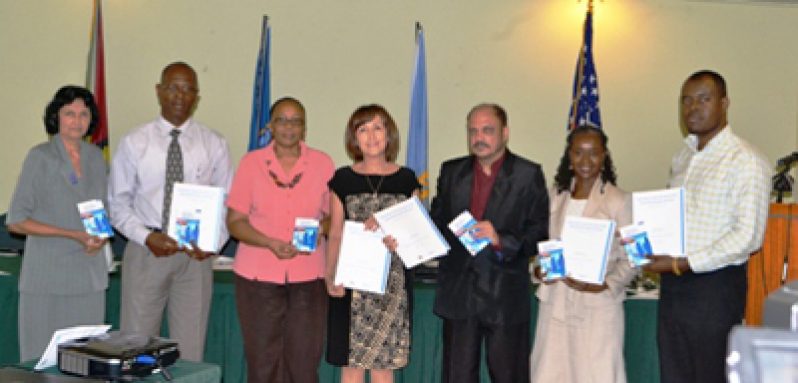THE Ministry of Health, last Wednesday, introduced the National Plan for Infection Prevention and Control 2012-2016, through the Standards and Technical Services Department and the Infection Control Manual, by the Georgetown Public Hospital Corporation (GPHC).
 Minister of Health, Dr. Bheri Ramsaran said the manuals, like the standard treatment guidelines are important to those in the medical field, especially new practitioners and it is a further step towards arming the workforce.
Minister of Health, Dr. Bheri Ramsaran said the manuals, like the standard treatment guidelines are important to those in the medical field, especially new practitioners and it is a further step towards arming the workforce.
He remarked that, in a resource poor environment, if the preventable approaches are not in place, the consequences can be burdensome, hence the importance of the documents.
Ramsaran recalled his days as a surgeon in the Surgical Department of the GPHC when it was a battle to deal with infections.
Pan American Health Organisation/World Health Organisation (PAHO/WHO) Representative, Dr. Rosalinda Hernandez remembered that, in 2009, efforts commenced to address infection control at the level of the hospital and the emergence of certain infections in Africa and South America highlight the urgent need for efficient practices in the health care system.
She said it is even much more critical, because the health care system is the front line of containment and response strategies and hospital based and public health surveillance must be formally and efficiently linked.
Hernandez pointed out that in developing countries health associated infection rates are not known, with only 23 out of 147 of them surveyed in 2010 reported a functioning health care associated infection national surveillance system.
Positive steps
While commending the local Ministry of Health and the GPHC for their positive steps towards addressing care associated infections, she emphasised that the introduction of the documentation will, indeed, aid in improving the quality of health care and decreasing the burden of infectious diseases.
New Charge d’Affaires at United States (U.S.) Embassy in Georgetown, Mr. Bryan Hunt concurred that, together, the two documents represent an opportunity for the Health Ministry and its partners to continue preventing the scourge of infections in the public health sector and, fundamentally, to save lives.
He posited that prevention remains the paramount challenge of the HIV/AIDS epidemic globally and it is also a major priority for the U.S. President’s Emergency Plan For AIDS Relief (PEPFAR). At the global level, it is estimated that, at least one-third of the nearly 33 million people living with HIV are infected with the bacteria that causes tuberculosis and, among all cases of active TB cases, 13 percent are co-infected with HIV.
Hunt admitted that, while PEPFAR has its role, Guyana’s Health Ministry should have full ownership of the project, so as to ensure sustainability.
He emphasised that having the National Plan for Infection Prevention and Control puts Guyana into a very exclusive group of countries and one of the few in the Southern Hemisphere that is able to implement such a plan.
GPHC Chief Executive Officer, Mr. Michael Khan expressed satisfaction that the institution is at a place where a lot of deficiencies that were not completely addressed in the past could now be corrected.
He hopes that the manuals will be disseminated to all health facilities in Guyana and, most importantly, that the care professionals put the theory into practice.
Khan offered his appreciation to the PAHO/WHO Centre for Disease Control (CDC) and Canadian International Development Agency (CIDA) for their support in the preparation and production of one of the manuals.
He said the work now begins and the GPHC, which is the pioneer in infection prevention and control, will continue to be the leader in this regard.
In her presentation on the GPHC’s infection control documentation, Nurse Caroline Hicks noted that the outcome of the GPHC Infection Prevention and Control Manual demonstrates that the various sectors/units of the health care system can collaborate to overcome emerging challenges.
Establish policies
As such, the hospital’s infection control programmes help health care organisations to monitor and improve practices, identify risks and, proactively, establish policies to prevent the spread of infections. The primary function of the Infection Prevention and Control Department/Committee, includes educating staff, creating a multi-disciplinary team, collecting, analysing and communicating it, developing a relevant action plan and keeping up-to-date on policies and news, she related.
The GPHC’s manual seeks to provide general information and guidelines on infection control, by addressing standard precautions, hand hygiene, isolation precautions, waste management and cleaning, disinfecting and sterilisation.
Director of the Health Ministry Standards and Technical Services, Dr. Julian Amsterdam, in his presentation, explained that the goal of its documentation to reduce transmission of health associated infections (HAIs).
The objectives are to prevent and control them in local health facilities, organise the relevant actions at a national level, perform a situational diagnosis on infections nationwide, implement the epidemiological surveillance of HAIs, prepare the national standards on the IPC, train and educate the personnel in the associated tasks and support implementation, monitoring and assessing the general measures.
Amsterdam said the Ministry is committed to providing a higher quality of life for the population by preventing health care associated infections and the goal of minimising them can only be realised through commitment and rigorous execution of roles and responsibilities by the workers and managers at all levels.



.jpg)











